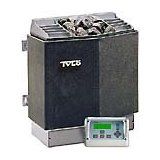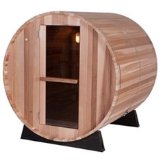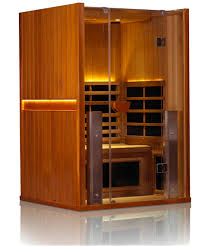Benefits of Infrared Sauna - How They Compare to Traditional
The benefits of infrared sauna technology come from the use of far infrared rays (FIR), mid infrared (MIR) and near infrared rays (NIR), which have the ability to penetrate soft tissue up to an inch and a half and radiate thermal energy to the human body.
As the body warms, the blood vessels are opened up allowing for increased circulation. This process is called “vasodilation” and it has many proven health benefits.
Since infrared technology uses lower levels of heat it is safe enough for use in many medical applications, including keeping babies warm in nurseries and NICU’s and as part of standard physical therapy routines.
In our modern world, infrared sauna therapy has been adapted to home use as an alternative to traditional saunas while still providing the same health benefits.
Here we are going to explore both the benefits of infrared saunas compared to traditional ones with wood, electric and gas heat, as well as the health benefits that are specific to infrared heat.
Infrared Benefits vs. Traditional Saunas

In addition to all the health benefits infrared saunas can provide, there are some more practical benefits in terms of temperatures, heating method, heat-up time, and length of sauna session.
Temperature
Because infrared saunas work by heating the object (your body) directly rather than heating the entire room, they generally operate at a much lower temperature than traditional saunas.
Infrared saunas heat to about 110°F-130°F while the heat in a traditional steam sauna, falls between 180°F and 200°F. In both cases, the ultimate goal is to work up a sweat and enjoy the health benefits of doing so but since infrared saunas work at a lower temperature individual sauna sessions may be longer.
Heating Method
A traditional sauna works by using a heater to heat a bed of rocks, which then radiate that stored heat into the room, heating the air around you. Steam can be added to the experience by pouring water over the rocks. Traditional sauna heaters can be either electric, gas, propane or wood stove.
In infrared saunas emitters are used to create infrared energy which penetrates through your skin into your body to warm the body directly. Because there are no rocks to retain the heat, an infrared sauna will cool immediately when the sauna is shut off so it’s important for the emitters to remain running almost constantly. In a traditional sauna, the heater can cycle on an off and the room will still retain some heat via the rocks.
Heat-up Time
The amount of time it takes to heat up your sauna will vary depending on the specific type of heater: electric, gas/propane, wood or infrared. In general, traditional heaters can take anywhere between 30-40 minutes to reach desired temperature. Once it reaches the set temperature, the heater will cycle on and off, actually running only about 50% of the time. In an infrared sauna, you can actually begin bathing as soon as the room is turned on as the emitters will begin producing heat immediately, however it can take about 15 minutes for the room to reach 100̊.
Length of Sauna Session – In general, doctors recommend using any type of sauna for about 10-15 minutes per session, however since infrared saunas operate at a lower temperature it may be possible to extend your session to as much as 20-30 minutes in an infrared sauna.
Let's look at how infrared heat compares to specific types of traditional heaters...
Infrared vs. Electric
Traditional electric sauna heaters must be connected to your home’s electrical system, which means you’ll need a licensed electrician to ensure that installation is done correctly and safely. That can mean an extra installation cost of $3,000-$6,000 depending on the size of your sauna. Conversely, most infrared saunas are 110V and can be plugged into an existing outlet.
Aside from installation there is also a distinct difference in operating cost between the two. Traditional saunas tend to be slightly larger in size, so it will take more energy to heat them. A standard two person sauna, which is usually around 5’ x 6’, uses a 4.5kW heater which will cost approximately $.37 for the first hour of operation and then $.25 each subsequent hour as it cycles on and off. A two person infrared sauna, on the other hand, measures about 4’ x 4’ and will cost approximately $.18 an hour to run.
Infrared vs. Gas/Propane
Like electric heaters, gas/propane heaters will require a licensed contractor to install. The installation cost is similar to that of an electric heater, around $3,000-$6,000. Operating cost is also similar to electric heaters and will generally be about $.7-$.10 more than the cost of running an infrared heater.
From a practical standpoint, gas heaters require venting to ensure that there is proper air circulation. Again, an infrared sauna can just be plugged in and used as is, making it much more convenient and safer.
Infrared vs. Wood Fire Stove
Many people prefer the ambiance of a traditional wood stove heater, with the crackling of the fire and feel of the steam rising from the rocks. There are some distinct disadvantages when you compare a wood fire sauna to an infrared, however.
While a wood stove doesn’t require professional installation it does necessitate a chimney for venting the smoke. It also necessitates a continual source of wood, which can be costly. A cord of wood can cost anywhere from $300-$600 depending on the type of wood.
In direct comparison, the major benefit to an infrared sauna is the ability to reach and regulate temperature. A wood fire sauna can take as long as 30-60 minutes to reach the desired heat level and will need constant adjusting to maintain that heat level. As stated above, an infrared sauna is almost instantly ready to use and will reach peak heat within 15 minutes. Once it reaches peak it will stay there continuously since the emitters remain on at all times.
What About the Infrared Sauna Health Benefits?
During the sauna, the bather experiences profuse sweating due to the effects of the infrared energy. Most of the therapeutic benefits of an infrared sauna are largely superficial in terms of the body’s internal processes, but studies show there is definitely an increase of heart rate as well as an increase in circulation due to vasodilatation of the cutaneous (skin) blood vessels.
Some other known benefits of infrared sauna use include:
· Detoxification – As infrared saunas increase blood circulation and stimulate the sweat glands, this leads to the release of built-up toxins in the body. Daily infrared sauna sessions can help to rid the body of a number of toxins including heavy metals like lead and mercury, alcohol, nicotine, sulfuric acid and other potentially harmful compounds.
· Stress reduction – There’s little doubt that just a few minutes in an infrared sauna can leave you feeling relaxed and rejuvenated. The gentle warmth of the FIR help to put your nervous system in what’s called the “parasympathetic” state, meaning a state of rest that can allow the body to heal and replenish.
· Reducing Inflammation – Infrared sauna use has been linked to relief from inflammation, stiffness and soreness related to arthritis and other musculoskeletal ailments. Even the normal stiffness, aches and pains associated with aging can be reduced with regular time spent in an infrared sauna.
· Boosted Immune Response – As the FIR penetrate the body and raise your core temperature, that results in an artificial fever. Since fever is the body’s natural response to infection, producing it helps to engage the immune system, improving your natural immune response and increasing your ability to eliminate toxins while increasing overall health and improving resistance to disease.
· Improved Skin Health – the excess sweating caused by infrared sauna use can have wonderful health benefits for your skin as it helps to eliminate impurities and slough off dead skin cells while natural nutrients are drawn to the surface. The result is skin with a healthy glow, improved tone and better elasticity. Improved blood circulation from the FIR can also help to heal various skin conditions including acne, eczema and psoriasis as well as aid in wound healing to diminish the appearance of scars.
· Improved Cardiac Health – of course, improved circulation can greatly benefit your overall cardiac health but the regular use of FIR can also help to reduce blood pressure, lower cholesterol levels and reduce chronic pain.
· Reduced Cellulite – women in particular are often impacted by the appearance of cellulite, or superficial pockets of trapped fat, that can occur on various parts of the body. The radiant heat of FIR is much more effective at reducing cellulite than traditional saunas because it penetrates much deeper.
· Decreased Side Effects of Diabetes – the ability of FIR to aid in eliminating toxins, improving circulation and cleansing internal organs has been shown to help decrease the side effects of Diabetes.
What About Weight Loss Claims?
Claims that weight loss is one of the benefits of infrared sauna use are somewhat exaggerated. The radiant heat will cause you to perspire and lose fluids but the water weight will be regained once you drink fluids again.
Yet the assertion that calories are burned during sauna therapy remains true; the body uses 0.568K calories to produce just one gram of sweat. So a fit person sitting in an infrared sauna for 30 minutes produces up to 500 grams of sweat which equates to almost 300 kcal consumed. The water loss can be replenished immediately, yet calories are burned nonetheless.
During an infrared sauna session, your heart rate increases as your body attempts to sweat enough to cool down your core. This increased heart rate, which can be up to 75% in some people, is similar to an elevated heart rate that occurs during exercise.
Of course, you don’t have the same load bearing workout that a walk or run gives your bones and muscles, so sitting in a sauna in no way replaces exercise the body needs. But for people who are unable to exercise, infrared sauna therapy can help to achieve the benefits of increased cardiovascular activity.
While some of the medical benefits of infrared sauna use have been questioned, there have been no findings that home infrared saunas are in any way unsafe. All medical professionals, however, do agree that sweating is always good for you as long as you’re healthy and can stay sufficiently hydrated.
Infrared Sauna Benefits - Bottom Line
An infrared sauna offers many benefits, both health related and practical. They offer a number of advantages over traditional saunas, which is why they have become so popular in recent years.
Whichever type of sauna you choose, know that you are taking steps to improve your health...so enjoy all the benefits that saunas offer!
Infrared Saunas
Sauna Heaters

How to Install a Wood Sauna Heater
Sauna Kits

Buying Guide




